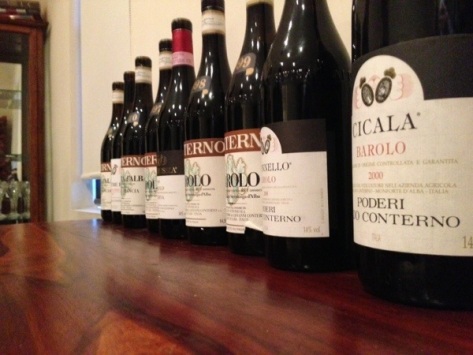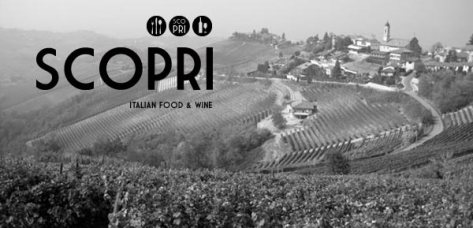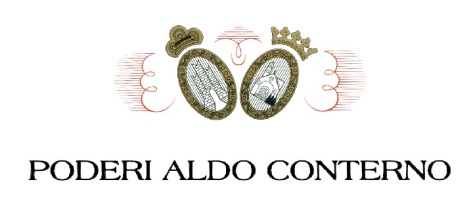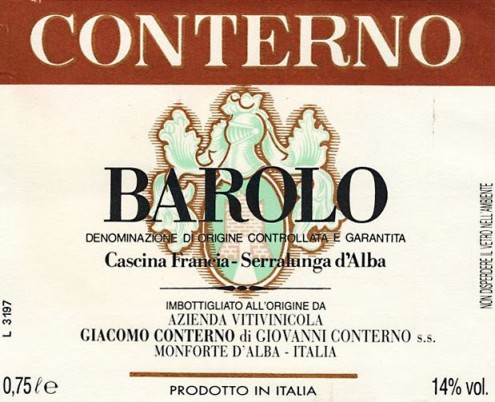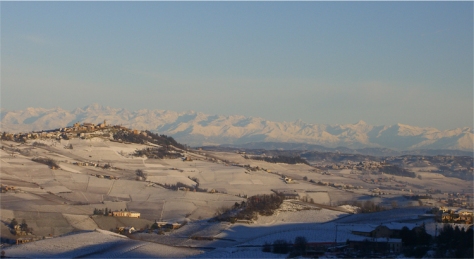For the next two weeks I will be away with my family on a beach vacation. Family, sun, sand and plenty of #realitalianbeer and vino. Perfect 🙂
Monthly Archives: October 2012
Who said Rosso is not serious?
A trip to Montalcino earlier this year really got me excited again for Brunello and Rosso di Montalcino; and it was the wines of Biondi Santi, Fuligni, Soldera and Il Palazzone that I really fell in love with.
After the trip we made the decision to add Il Palazzone to the @mondoimports portfolio and over the last six months I have been drinking Brunello and Rosso from these producers.
Last night we drank a bottle of Biondi Santi Rosso di Montalcino 2008 and boy was it good: complex, savoury and many layers of fruit perfectly matched with fine tannins. This wine will age for many years.
Next month I will be hosting a dinner at Scopri looking at fifteen different 2004 Brunello di Montalcino producers and it should be a blast with the best of the best represented.
Two brothers tale of Barbera & Barolo: Aldo & Giacomo Conterno @Scopri….
Last week a group of Italian wine lovers went to Scopri Restaurant to feast on some fantastic food and drink some delightful Barolo’s from Aldo and Giacomo Conterno.
The aim of the dinner was to compare and contrast the styles of these two winemakers and wineries. It was not to see who produced better wines as both producers, although stylistically different are at the top of the tree when it comes to quality Barolo.
Below is some history of the two wineries and also my brief notes in Italic on the wines.
Their father was the acclaimed Barolista Giacomo Conterno, one of the denomination’s twentieth century pioneers who in 1920 began bottling the family’s Barolo Riserva, so heralding the birth of Monfortino, arguably Barolo’s most iconic wine.
In 1961, Conterno and his brother Giovanni inherited the Giacomo Conterno winery; the two brothers went their separate ways in 1969 and Aldo created his own estate, Poderi Aldo Conterno, in Bussia in Monforte d’Alba.
‘Aldo Conterno was really a great man. He made Barolo history over the last fifty years by continuing to take the reputation of this unique wine to its highest level,’ said Pietro Ratti, a Barolo producer and president of the Consorzio di Tutela Barolo Barbaresco Alba Langhe e Roero.
One of the secrets of Conterno’s success, besides owning prime vineyards, was his open-mindedness, a quality few other Barolo producers from his generation possessed, and a trait which perhaps originated when Conterno moved to California in the 1950s to help his uncle establish a winery.
Soon after arriving however, Aldo opted to complete his mandatory Italian military service in the US Army and served during the Korean War. By the time he got out, his uncle had abandoned the winery venture and Conterno returned to Piedmont.
Aldo became known for balancing tradition with new techniques. By the 1970s, in an effort to reduce Barolo’s massive tannins, he had reduced customary fermentation times and abandoned the submerged cap method in favor of pumping over – all radical decisions at the time.
Although he allowed his sons Franco, Stefano and Giacomo to use barriques for the firm’s other wines, he insisted on large Slavonian casks for Barolo.
‘Vanilla, toast, spice and sweet tannins don’t belong in Barolo,’ he said. Aldo Conterno’s celebrated Barolos include Granbussia Riserva and single vineyard bottlings Romirasco, Cicala and Colonnello. Decanter

Aldo Conterno Conca Tre Pile Bussia 2009 Barbera Alba
SPECIES OF VINE: Barbera.
VINEYARD: Conca Tre Pile in Bussia (Monforte d’Alba).
HARVEST: manual, with grapes selection in the vineyard.
TIME OF HARVEST: first week of October.
VINIFICATION: red, with skin soaking inside stainless steel vats.
VINIFICATION TIME: the must stays on contact with the skins for about 8 to 10 days and it is further drawn off wine ; finally, the alcoholic VINIFICATION gets complete. VINIFICATION TEMPERATURES: from 26 to 28 degrees centigrades.
CELLAR REFINING: the new wine spends a few months inside stainless steel vats, it is transferred several times, and, consequently, it is poured onto barrels (“barriques”) where it remains for 12 months; finally, it will be bottled.
NOTES: the “Conca Tre Pile” is a hilly area in Bussia Soprana whose main vines are Barbera’s with vineyards having a maximum age of 45 years. The barrels (“barriques”) are 100% made of new wood.
Oak on the nose, touch of banana peel. Needs to settle on the palate but there is no doubting that the fruit will match the wine and this will be a fantastic wine in time. 6-8 years will be perfect.
Giacomo Conterno Cascina Francia 2009 Barbera d’Alba
The 2009 Barbera d’Alba Cascina Francia is at first quite a bit more floral and ethereal than the Cerretta, but with time in the glass the wine finds its center. The Cascina Francia dazzles with its combination of expressive, generous fruit and insistent minerality. Sweet herbs, roses, spices, anise, licorice and leather add complexity to a core of radiant fruit. This is a regal, aristocratic Barbera of the highest level. The 2009 has the openness of vintages such as 2007, but with the medium-bodied structure and finesse of silkier vintages such as 2004, which is a very appealing combination. This is a very complete, harmonious wine from Roberto Conterno. Anticipated maturity: 2012-2029. 93 points Antonio Galloni, Wine Advocate 197, October 2011
Pure Barbera, such a lovely wine. Balance is the key and this has it in spades. I could smell this wine all night and just shows how good Barbera can be: Drink now or cellar for a decade.
Giacomo Conterno Cascina Francia 2010 Barbera d’Alba
The 2010 Barbera d’Alba Cascina Francia is bigger, richer and broader than the Cerretta. Rose petals, sweet herbs, plums and dark cherries wrap around the palate in this striking, intensely satisfying Barbera. Anticipated maturity: 2015-2030 (92-94) points Antonio Galloni, Wine Advocate 200, October 2012
Awesome wine. Hard to think that the 2009 could be bettered but this wine has done it. Impeccable balance, lovely poise and fruit and acid in perfect harmony. Drink or cellar for 15 years.
Aldo Conterno Grand Bussia Barolo 1997
VINIFICATION: in wood with maceration of the skins in large Slavonia oak casks.
PECIES OF VINE: Nebbiolo, Michet and Lampia varieties.
VINEYARD: Romirasco, Cicala and Colonnelo vineyards (Bussia – Monforte d’Alba).
HARVEST: manual, with grapes selection in the vineyard.
TIME OF HARVEST: mid-October.
VINIFICATION TIME: the must remains in contact with the skins for 60 days, during which the alcoholic fermentation is fully completed.
VINIFICATION TEMPERATURES: variable with maximum peaks of 32 degrees centigrade.
CELLAR REFINING: once removed the new wine remains in large Slavonia oak casks where it ages and refines for 32 montha.
NOTES: the Barolo Reserve Granbussia is produced by blending grapes from the oldest vines, from the Romirasco, Cicala, and Colonnello, before fermentation starts, in the following percentages respectively: 70% – 15% – 15%. Naturally these optimal values may vary depending on the year.
The Granbussia remains in the cellar for at least 7 years before commercialization. It is produced exclusively in the best years and in limited quantities.
Granbussia, the Barolo Riserva of the house, is made principally from the grapes of the Romirasco vineyard, the estate’s highest, and the altitude was obviously of real assistance in the unusually hot year of 1997. The 1997 Barolo Riserva Granbussia, quite fresh for the vintage, features a sweet, ripe, floral and tarry nose, fine cherry and plum fruit on the rich and full-bodied palate along with minerals, herbs, licorice, and asphalt. Though always a long-lived wine, it generally comes around earlier than Vigna Cicala, and I would choose to drink the wine between 2005 and 2020. 92 points, Daniel Thomases, Wine Advocate #149 Oct 2003
Looking good, touch of oak on the nose and is still well fruited and balanced. I think 1997 is an overrated vintage in Barolo but this is one of the better examples.
Giacomo Conterno Cascina Francia 1997 Barolo Monforte
1997 Barolo Cascina Francia—Dark ruby. Incredibly beautiful nose of dried flowers and sweet fruit. The 1997 is dense and lush on the palate, showing very ripe dark cherry fruit, with notable extract and glycerin. Another wine that is just singing today, the alluring and irresistible 1997 offers superb drinking now. 92+ points Antonio Galloni In the Cellar Jul 2005
Lovely length, really good bottle of 1997. Still lots of primary red savoury fruits but this is at the perfect stage of development to drink. Well done.
Giacomo Conterno Cascina Francia 1998 Barolo Monforte
The 1998 Barolo Cascina Francia from Giacomo Conterno is delicate, layered and perfumed, showing gorgeous finesse and lovely inner tension in its fruit. Overall this is a soft, accessible Cascina Francia that is drinking beautifully today and should last for at least another decade. Both bottles I tasted from the property were truly sublime but I should point out that I, and others, have had decidedly different experiences with bottles purchased in the US, which have often come across as more austere for reasons that admittedly remain somewhat of a mystery. For those who are curious, I didn’t included a note on the 1998 Monfortino as it doesn’t take a rocket scientist to conclude that the wine is much too young to deliver any real pleasure at this stage, no matter how thrilling the wine might be to taste! Anticipated maturity: 2009-2019. 93 points Antonio Galloni In the Cellar Mar 2009
Amazing wine, awesome, perfect balance ethereal, in the groove. One of my Barolo highlights for the year. A classic example why the wines of Giacomo Conterno are held in such high regard.
Giacomo Conterno Cascina Francia 1999 Barolo Monforte
1999 Barolo Cascina Francia—Dark lively red. The exceptional and outrageously decadent 1999 exemplifies the very best qualities of traditional Barolo. A wine of great length and persistence, it offers a multidimensional nose of sweet fruit, minerals and tar and a dense, layered personality bursting with flavors of dark ripe fruit, tar, roses and mint. Of these first four wines, the 1999 is clearly in a league of its own. 94 points/drink after 2009, tasted 05/05 Antonio Galloni In the Cellar Jul 2005
Conterno makes two Barolos both from the Cascina Francia vineyard, one of the great monopole sites in Piedmont. The vineyard was purchased by Giovanni Conterno in 1974 and measures six hectares. Cascina Francia is made in a traditional style, with natural yeasts and temperature-controlled fermentation and maceration lasting 3-4 weeks. The wines are aged in large Slavonian oak casks and are bottled in the summer of the fourth year following the harvest. In great vintages a special selection of the best fruit is made in the vineyard and that fruit becomes the Barolo Riserva Monfortino, perhaps the single most iconic wine in all of Piedmont. Monfortino is also made with natural yeasts, although fermentation/maceration time is longer, lasting 4-5 weeks, and is carried out without the aid of temperature control. Current vintages are aged seven years in cask, but past vintages have seen as much as 10 years of cask aging before being released. Monfortino is legendary for its extraordinary longevity, which is usually measured in decades. Antonio Galloni In the Cellar Jul 2005
Two bottles, one slightly off, the other just bad.
Aldo Conterno Bussia Colonnello 2000 Barolo Monforte
SPECIES OF VINE: Nebbiolo, Michet and Lampia varieties.
VINEYARD: “Colonnello” vineyard, in Bussia (Monforte d’Alba).
HARVEST: manual, with grapes selection in the vineyard.
TIME OF HARVEST: mid-October.
VINIFICATION: red, with skin soaking inside stainless steel vats.
VINIFICATION TIME: the must stays on contact with the skins for 30 days: during this time the alcoholic VINIFICATION gets fully complete, and the wine is then drawn off.VINIFICATION TEMPERATURES: changeable, with highest peaks of 32 degrees centigrades.
CELLAR REFINING: The new wine is racked several times before transfer to large Slavonia oak casks where it is aged and refined for 28 months.
NOTES: the vineyard “Colonnello” is about 40-45 years old and, to maintain it, its vines are replanted from time to time. The main variety of Nebbiolo is Michet and its rootstock is 420 A.
The 2000 Barolo Colonnello reveals a pretty bouquet with early stages of tertiary development. Tobacco, licorice and sweet spices emerge from the Burgundian bouquet. The Colonnello has aged evenly and gracefully. The tannins have melted away while the fruit is soft and expressive. Anticipated maturity: 2011-2018. 91 points, Antonio Galloni Wine Advocate #195 Jun 2011
Classic Barolo, again touch of oak on the nose but so well balanced and impeccable structure. This is in it’s prime at the moment but will not fade anytime soon.
Aldo Conterno Bussia Cicala 2000 Magnum 1,5 lt. Barolo Monforte
SPECIES OF VINE: Nebbiolo, Michet and Lampia varieties.
VINEYARD: “Cicala” vineyard, in Bussia (Monforte d’Alba).
HARVEST: manual, with grapes selection in the vineyard.
TIME OF HARVEST: mid-October.
VINIFICATION: red, with skin soaking inside stainless steel vats.
VINIFICATION TIME: the must stays on contact with the skins for 30 days: during this time the alcoholic
VINIFICATION gets fully complete, and the wine is then drawn off.
VINIFICATION TEMPERATURES: changeable, with highest peaks of 32 degrees centigrades.
CELLAR REFINING: The new wine is racked several times before transfer to large Slavonia oak casks where it is aged and refined for 28 months.
NOTES: the vineyard “Cicala” [meaning: balm-cricket] is about 40-45 years old and its vines are replanted from time to time. The main variety of Nebbiolo is Lampia and its rootstock is Rupestris du Lot.
The 2000 Barolo Cicala opens with gorgeous notes of crushed berries. The 2000 is a relatively small-scaled, lithe Cicala that shows excellent freshness all the way through to the long finish. The wine gains energy and focus in the glass, with suggestions of menthol and pine that add lift. Anticipated maturity: 2012-2020. 93 points, Antonio Galloni Wine Advocate #195 Jun 2011
Wow!! Aldo at his best. In the groove, balanced and integrated. Probably the best bottle/magnum of Aldo Conterno I have drunk.
All in all, it was a great night and there is nothing better to drink these wines with people who love and appreciate these wines. The food was fantastic (as it always is at Scopri) and both Aldo and Giacomo Conterno illustrated the heights they can hit with their wines. Nearly all the wines didn’t miss a beat and even though both wineries produce markedly different styles wines, I did not have a preference for a producer on the night.
Amazing wines: amazing dinner
Traversa Il Ciabot Langhe Nebbiolo 2010: seriously good Nebbiolo….
I have written a few posts on just how much I love the wines of Traversa from Barbaresco. They are pure expressions of Nebbiolo and they make the wines like they have been made for generations past.

The just landed 2010 Langhe Nebbiolo has just been given a big tick of approval by Gary Walsh from The Wine Front.
It’s declassified Barbaresco, which means that the 2010 Barbarescos from this producer should be pretty bloody good.. Importer: Mondo Imports.
Leather, cherry, Amaretto, red fruit, wood smoke – deep. It’s medium bodied, spicy and chewy and fresh all at once–ample musculature on show–though not without finesse. Dense with strong tannin impact and a long finish. Unevolved as young wine – it needs time. Amazing value. Drink : 2015 – 2025+ 93 points Gary Walsh, The Wine Front
My idea of heaven….
Two brothers tale of Barbera & Barolo: Aldo and Giacomo Conterno @ Scopri Thursday 18th October
On Thursday the 18th of October at Scopri Food and Wine, I will be running the second of a series of dinners’ looking at the best winemakers and best wines of Italy.
This dinner is a comparison of two great brothers who started off at their family winery together before Aldo went his own way. This dinner is sold out, but if you would like to get on the waiting list for this dinner or are interested in future dinners email me at anthdanna@gmail.com
Their father was the acclaimed Barolista Giacomo Conterno, one of the denomination’s twentieth century pioneers who in 1920 began bottling the family’s Barolo Riserva, so heralding the birth of Monfortino, arguably Barolo’s most iconic wine.
In 1961, Conterno and his brother Giovanni inherited the Giacomo Conterno winery; the two brothers went their separate ways in 1969 and Aldo created his own estate, Poderi Aldo Conterno, in Bussia in Monforte d’Alba.
‘Aldo Conterno was really a great man. He made Barolo history over the last fifty years by continuing to take the reputation of this unique wine to its highest level,’ said Pietro Ratti, a Barolo producer and president of the Consorzio di Tutela Barolo Barbaresco Alba Langhe e Roero.
One of the secrets of Conterno’s success, besides owning prime vineyards, was his open-mindedness, a quality few other Barolo producers from his generation possessed, and a trait which perhaps originated when Conterno moved to California in the 1950s to help his uncle establish a winery.
Soon after arriving however, Aldo opted to complete his mandatory Italian military service in the US Army and served during the Korean War. By the time he got out, his uncle had abandoned the winery venture and Conterno returned to Piedmont.
Aldo became known for balancing tradition with new techniques. By the 1970s, in an effort to reduce Barolo’s massive tannins, he had reduced customary fermentation times and abandoned the submerged cap method in favor of pumping over – all radical decisions at the time.
Although he allowed his sons Franco, Stefano and Giacomo to use barriques for the firm’s other wines, he insisted on large Slavonian casks for Barolo.
‘Vanilla, toast, spice and sweet tannins don’t belong in Barolo,’ he said. Aldo Conterno’s celebrated Barolos include Granbussia Riserva and single vineyard bottlings Romirasco, Cicala and Colonnello. Decanter
Aldo Conterno Conca Tre Pile Bussia 2009 Barbera Alba
SPECIES OF VINE: Barbera.
VINEYARD: Conca Tre Pile in Bussia (Monforte d’Alba).
HARVEST: manual, with grapes selection in the vineyard.
TIME OF HARVEST: first week of October.
VINIFICATION: red, with skin soaking inside stainless steel vats.
VINIFICATION TIME: the must stays on contact with the skins for about 8 to 10 days and it is further drawn off wine ; finally, the alcoholic VINIFICATION gets complete. VINIFICATION TEMPERATURES: from 26 to 28 degrees centigrades.
CELLAR REFINING: the new wine spends a few months inside stainless steel vats, it is transferred several times, and, consequently, it is poured onto barrels (“barriques”) where it remains for 12 months; finally, it will be bottled.
NOTES: the “Conca Tre Pile” is a hilly area in Bussia Soprana whose main vines are Barbera’s with vineyards having a maximum age of 45 years. The barrels (“barriques”) are 100% made of new wood.
Giacomo Conterno Cascina Francia 2009 Barbera d’Alba
The 2009 Barbera d’Alba Cascina Francia is at first quite a bit more floral and ethereal than the Cerretta, but with time in the glass the wine finds its center. The Cascina Francia dazzles with its combination of expressive, generous fruit and insistent minerality. Sweet herbs, roses, spices, anise, licorice and leather add complexity to a core of radiant fruit. This is a regal, aristocratic Barbera of the highest level. The 2009 has the openness of vintages such as 2007, but with the medium-bodied structure and finesse of silkier vintages such as 2004, which is a very appealing combination. This is a very complete, harmonious wine from Roberto Conterno. Anticipated maturity: 2012-2029. 93 points Antonio Galloni, Wine Advocate 197, October 2011
Giacomo Conterno Cascina Francia 2010 Barbera d’Alba –Monforte
The 2010 Barbera d’Alba Cascina Francia is bigger, richer and broader than the Cerretta. Rose petals, sweet herbs, plums and dark cherries wrap around the palate in this striking, intensely satisfying Barbera. Anticipated maturity: 2015-2030 (92-94) points Antonio Galloni, Wine Advocate 200, October 2012
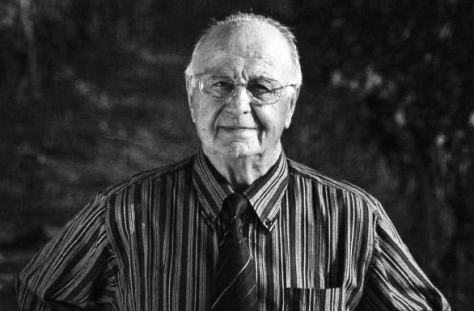
Aldo Conterno Grand Bussia Barolo 1997
VINIFICATION: in wood with maceration of the skins in large Slavonia oak casks.
PECIES OF VINE: Nebbiolo, Michet and Lampia varieties.
VINEYARD: Romirasco, Cicala and Colonnelo vineyards (Bussia – Monforte d’Alba).
HARVEST: manual, with grapes selection in the vineyard.
TIME OF HARVEST: mid-October.
VINIFICATION TIME: the must remains in contact with the skins for 60 days, during which the alcoholic fermentation is fully completed.
VINIFICATION TEMPERATURES: variable with maximum peaks of 32 degrees centigrade.
CELLAR REFINING: once removed the new wine remains in large Slavonia oak casks where it ages and refines for 32 montha.
NOTES: the Barolo Reserve Granbussia is produced by blending grapes from the oldest vines, from the Romirasco, Cicala, and Colonnello, before fermentation starts, in the following percentages respectively: 70% – 15% – 15%. Naturally these optimal values may vary depending on the year.
The Granbussia remains in the cellar for at least 7 years before commercialization. It is produced exclusively in the best years and in limited quantities.
Granbussia, the Barolo Riserva of the house, is made principally from the grapes of the Romirasco vineyard, the estate’s highest, and the altitude was obviously of real assistance in the unusually hot year of 1997. The 1997 Barolo Riserva Granbussia, quite fresh for the vintage, features a sweet, ripe, floral and tarry nose, fine cherry and plum fruit on the rich and full-bodied palate along with minerals, herbs, licorice, and asphalt. Though always a long-lived wine, it generally comes around earlier than Vigna Cicala, and I would choose to drink the wine between 2005 and 2020. 92 points, Daniel Thomases, Wine Advocate #149 Oct 2003
Giacomo Conterno Cascina Francia 1997 Barolo Monforte
1997 Barolo Cascina Francia—Dark ruby. Incredibly beautiful nose of dried flowers and sweet fruit. The 1997 is dense and lush on the palate, showing very ripe dark cherry fruit, with notable extract and glycerin. Another wine that is just singing today, the alluring and irresistible 1997 offers superb drinking now. 92+ points Antonio Galloni In the Cellar Jul 2005
Giacomo Conterno Cascina Francia 1998 Barolo Monforte
The 1998 Barolo Cascina Francia from Giacomo Conterno is delicate, layered and perfumed, showing gorgeous finesse and lovely inner tension in its fruit. Overall this is a soft, accessible Cascina Francia that is drinking beautifully today and should last for at least another decade. Both bottles I tasted from the property were truly sublime but I should point out that I, and others, have had decidedly different experiences with bottles purchased in the US, which have often come across as more austere for reasons that admittedly remain somewhat of a mystery. For those who are curious, I didn’t included a note on the 1998 Monfortino as it doesn’t take a rocket scientist to conclude that the wine is much too young to deliver any real pleasure at this stage, no matter how thrilling the wine might be to taste! Anticipated maturity: 2009-2019. 93 points Antonio Galloni In the Cellar Mar 2009
Giacomo Conterno Cascina Francia 1999 Barolo Monforte
1999 Barolo Cascina Francia—Dark lively red. The exceptional and outrageously decadent 1999 exemplifies the very best qualities of traditional Barolo. A wine of great length and persistence, it offers a multidimensional nose of sweet fruit, minerals and tar and a dense, layered personality bursting with flavors of dark ripe fruit, tar, roses and mint. Of these first four wines, the 1999 is clearly in a league of its own. 94 points/drink after 2009, tasted 05/05 Antonio Galloni In the Cellar Jul 2005
Conterno makes two Barolos both from the Cascina Francia vineyard, one of the great monopole sites in Piedmont. The vineyard was purchased by Giovanni Conterno in 1974 and measures six hectares. Cascina Francia is made in a traditional style, with natural yeasts and temperature-controlled fermentation and maceration lasting 3-4 weeks. The wines are aged in large Slavonian oak casks and are bottled in the summer of the fourth year following the harvest. In great vintages a special selection of the best fruit is made in the vineyard and that fruit becomes the Barolo Riserva Monfortino, perhaps the single most iconic wine in all of Piedmont. Monfortino is also made with natural yeasts, although fermentation/maceration time is longer, lasting 4-5 weeks, and is carried out without the aid of temperature control. Current vintages are aged seven years in cask, but past vintages have seen as much as 10 years of cask aging before being released. Monfortino is legendary for its extraordinary longevity, which is usually measured in decades. Antonio Galloni In the Cellar Jul 2005
Aldo Conterno Bussia Colonnello 2000 Barolo Monforte
SPECIES OF VINE: Nebbiolo, Michet and Lampia varieties.
VINEYARD: “Colonnello” vineyard, in Bussia (Monforte d’Alba).
HARVEST: manual, with grapes selection in the vineyard.
TIME OF HARVEST: mid-October.
VINIFICATION: red, with skin soaking inside stainless steel vats.
VINIFICATION TIME: the must stays on contact with the skins for 30 days: during this time the alcoholic VINIFICATION gets fully complete, and the wine is then drawn off. VINIFICATION TEMPERATURES: changeable, with highest peaks of 32 degrees centigrades.
CELLAR REFINING: The new wine is racked several times before transfer to large Slavonia oak casks where it is aged and refined for 28 months.
NOTES: the vineyard “Colonnello” is about 40-45 years old and, to maintain it, its vines are replanted from time to time. The main variety of Nebbiolo is Michet and its rootstock is 420 A.
The 2000 Barolo Colonnello reveals a pretty bouquet with early stages of tertiary development. Tobacco, licorice and sweet spices emerge from the Burgundian bouquet. The Colonnello has aged evenly and gracefully. The tannins have melted away while the fruit is soft and expressive. Anticipated maturity: 2011-2018. 91 points, Antonio Galloni Wine Advocate #195 Jun 2011
Aldo Conterno Bussia Cicala 2000 Magnum 1,5 lt. Barolo Monforte
SPECIES OF VINE: Nebbiolo, Michet and Lampia varieties.
VINEYARD: “Cicala” vineyard, in Bussia (Monforte d’Alba).
HARVEST: manual, with grapes selection in the vineyard.
TIME OF HARVEST: mid-October.
VINIFICATION: red, with skin soaking inside stainless steel vats.
VINIFICATION TIME: the must stays on contact with the skins for 30 days: during this time the alcoholic
VINIFICATION gets fully complete, and the wine is then drawn off.
VINIFICATION TEMPERATURES: changeable, with highest peaks of 32 degrees centigrades.
CELLAR REFINING: The new wine is racked several times before transfer to large Slavonia oak casks where it is aged and refined for 28 months.
NOTES: the vineyard “Cicala” [meaning: balm-cricket] is about 40-45 years old and its vines are replanted from time to time. The main variety of Nebbiolo is Lampia and its rootstock is Rupestris du Lot.
The 2000 Barolo Cicala opens with gorgeous notes of crushed berries. The 2000 is a relatively small-scaled, lithe Cicala that shows excellent freshness all the way through to the long finish. The wine gains energy and focus in the glass, with suggestions of menthol and pine that add lift. Anticipated maturity: 2012-2020. 93 points, Antonio Galloni Wine Advocate #195 Jun 2011
MYSTERY WINE…..
Southern Italian love in Melbourne: and the need to drink out of Burgundy glasses….
Yesterday I spent a good part of the day showing the four single cru’s of Passopisciaro from the 2009 vintage. It was a fascinating exercise and showed just how different each cru is due to the different altitudes on Mount Etna and the different lava flows for each site.
For me, my favourite cru of Passopisciaro is Rampante, delicate and fragrant but with so much power and tannins in the palate it makes you do a double take.
For me these Southern Italian wines and most Italian wine in general, needs to be drunk out of a burgundy glass. At an appointment yesterday, the four single cur’s were served in a Chianti/Riesling glass and the wines were so subdued. As soon as they were transferred in the right glassware, that Mount Etna magic was back in full force.






